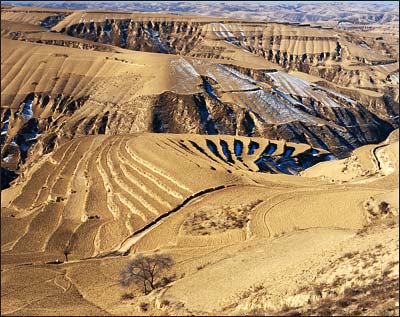When describing China's cultivated land and mineral resources,
people often use many huge numbers. Cultivated land, forests,
grasslands, deserts and tidelands are distributed widely across
China. Cultivated land is mainly located in east China, grasslands
are mainly located in the north and west, and forests mainly in the
remote northeastern and southwestern areas.
 |
In China today, 130.04 million ha of land are cultivated, mainly
on the Northeast Plain, the North China Plain, the Middle-Lower
Yangtze Plain, the Pearl River Delta and the Sichuan Basin. The
fertile black soil of the Northeast Plain, the largest plain in
China with an area of more than 350,000 sq km, abounds in wheat,
corn, soybeans, sorghum, flax and sugarbeet. The deep, brown
topsoil of the North China Plain is planted with wheat, corn,
millet and cotton. The Middle-Lower Yangtze Plain's flat terrain
and many lakes and rivers make it particularly suitable for paddy
rice and freshwater fish, hence its designation of "land of fish
and rice." This area also produces large quantities of tea and
silkworms. The purplish soil of the warm and humid Sichuan Basin is
green with crops in all four seasons, including paddy rice,
rapeseed and sugarcane, making it known as the "land of plenty."
The Pearl River Delta abounds with paddy rice, harvested 2-3 times
every year.
Forests cover only 174.91 million ha of China. The Greater
Hinggan, Lesser Hinggan and Changbai mountain ranges in the
northeast are China's largest natural forest areas. Major tree
species found here include conifers, such as Korean pine, larch and
Olga Bay larch, and coniferous-broadleaf trees such as white birch,
oak, willow, elm and Northeast China ash. Major tree species in the
southwest include the dragon spruce, fir and Yunnan pine, as well
as teak, red sandalwood, camphor, nanmu and padauk. Often called a
"kingdom of plants," Xishuangbanna in the south of Yunnan Province
is a rare tropical broadleaf forest area in China, playing host to
more than 5,000 plant species.
Grasslands in China cover an area of 400 million ha, stretching
more than 3,000 km from the northeast to the southwest. They are
the centers of animal husbandry. The Inner Mongolian Prairie is
China's largest natural pastureland, and home to the famous Sanhe
horses, Sanhe cattle and Mongolian sheep. The important natural
pasturelands north and south of the Tianshan Mountains in Xinjiang
are ideal for stockbreeding. The famous Ili horses and Xinjiang
fine-wool sheep are raised here.
China's cultivated lands, forests and grasslands are among the
world's largest in terms of sheer area. But due to China's large
population, the per-capita areas of cultivated land, forest and
grassland are small, especially in the case of cultivated land -
only one third of the world's average.
China is rich in mineral resources, and all the world's known
minerals can be found here. To date, geologists have confirmed
reserves of 158 different minerals, putting China third in the
world in terms of total reserves. Reserves of the major mineral
resources, such as coal, iron, copper, aluminum, stibium,
molybdenum, manganese, tin, lead, zinc and mercury, are in the
world's front rank. China's basic coal reserves total 337.34
billion tons, mainly distributed in northwest China and north
China, with Xinjiang Uygur Autonomous Region, Shanxi Province and
the Inner Mongolia Autonomous Region heading the field. China's
21.76 billion tons of the basic iron ore reserve are mainly
distributed in northeast, north and southwest China. The country
also abounds in petroleum, natural gas, oil shale, phosphorus and
sulfur. Petroleum reserves are mainly found in northwest, northeast
and north China, as well as in the continental shelves of east
China. The national reserves of rare earth metals far exceed the
combined total for the rest of the world.
(China.org.cn)